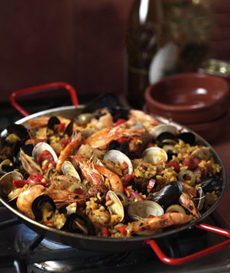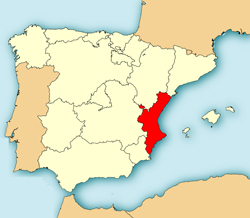
 Paella marisco, or seafood paella. The paella pan with the handsome red heat-proof handles is available at SurLaTable.com. Photo courtesy Sur La Table. Paella marisco, or seafood paella. The paella pan with the handsome red heat-proof handles is available at SurLaTable.com. Photo courtesy Sur La Table.
KAREN HOCHMAN is editorial director of THE NIBBLE.
|
March 2010
Last Updated March 2018
|
 |
Recipe: Paella Valenciana
Page 1: The History Of Paella, One Of The World’s Great Rice Dishes
CAPSULE REPORT: Paella is one of the world most famous rice dishes, with a memorable combination of ingredients. It’s a treat for a family dinner and a great party buffet dish. There are many ingredients, but it’s worth the effort. The recipes tend to make a lot of paella, which you can enjoy for a few days until it’s time to make another! This is Page 1 of a two-page article. Click on the black link below to visit Page 2.
Paella History
Many cultures have rice dishes that have become famous on the world culinary stage: arroz con pollo from Spain, biriyani from Spain, jambalaya from Louisiana, pilaf from the Middle East and risotto from Italy.
Rice originated in Asia and, along with pasta, was brought to the Mediterranean by the Moors. When the Moors invaded Spain, they brought both products with them. The Moorish casseroles of rice and fish established the custom of eating rice in Spain. By the 15th century, when Spanish Catholics expelled the Muslims from Spain, rice had become a national staple.
Fast forward a few hundred years: March 27th is National Paella Day in the U.S.
The Meaning Of “Paella”
Paella (pronounced pie-AY-ya) was originally made by agricultural laborers, who cooked the mixture of rice, snails and vegetables in a pan over an open fire in the fields. It was at first a communal dish, eaten directly from the pan with wooden spoons. Other Valencians closer to the coastline added eel and butter beans. The more elegant paellas loaded with chorizo, chicken and seafood did not evolve until living standards rose in the late 18th century century, when the dish went upscale.
The dish originated in Valencia, a region on the East coast of Spain (see map below), and evolved, depending on the inspiration of cooks. By the mid-1800s, paella included short-grain white rice and a mix of proteins: chicken, duck, rabbit and optional snails (less affluent people often made do with snails alone). The dish was actually a “rice and beans” dish, with butter beans, great northern beans and runner beans (artichoke replaced runner beans in the winter), plus tomatoes. The spices included garlic, pimentòn (sweet paprika), rosemary, saffron and salt; the dish was cooked in olive oil.
The recipe continued to evolve as chorizo, green beans, green peas, olives and roasted red pepper found their way into the dish.
The name “paella” derives from the Old French word for pan, paelle, from the Latin word patella. Today, the pan is called a paellera, but that term evolved after paella became popular. Paelleras are round and shallow, made of polished steel with two handles. There are even woven baskets that fit the pan to make a nicer presentation at the table—but today’s double-gauge steel paella pans are stunners in of themselves.
|
|

The Valencia region of Spain. Map courtesy Wikimedia. |
Valencians on the Mediterranean coast used the plentiful seafood instead of meat and beans to make seafood paella. Later, the seafood concept was combined with the original Valencian recipe and mixed paella was born: a saffron-flavored rice dish with meats and seafood, along with roasted red peppers, olives and other local vegetables.
What distinguishes paella from other rice dishes with meat, fish and vegetables is the saffron. Saffron grows wild in Spain, and not only gives a rich and unique flavor to the rice, but a deep yellow color as well.
Paella has become popular throughout Western Europe, North America and Latin America, and was adapted by European immigrants to Louisiana, who used local ingredients to create the dish known as jambalaya (see recipe and history).
Types Of Paella
While it’s easy to vary the ingredients to create any type of paella—from mixed poultry, root or spring vegetable variations to vegetarian/vegan paella—there are three main classic styles:
- Paella Valenciana: Valencian paella with white rice, green vegetables, meat (rabbit, chicken, duck), snails, beans and seasoning
(Note that in the U.S., “Paella Valenciana” is actually paella mixta, with seafood and meat combined—and a combination preferred by most people)
- Paella de marisco: seafood paella, which replaces meat and snails with seafood and omits beans and green vegetables
- Paella mixta: mixed paella, which is a free-style combination of meat, seafood, vegetables and sometimes beans
If we’ve whetted your appetite, turn to the next page for the recipe!
Continue to Page 2: Paella Recipe
Go To The Article Index Above

|